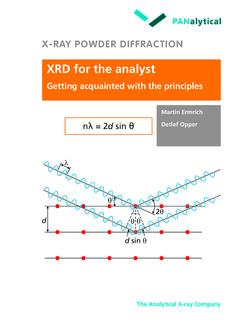Transcription of introduction to neutron scattering - NIST
1 1 Chapter 6 - introduction TO neutron scattering neutron scattering is the technique of choice for condensed matter investigations in general because thermal/cold neutrons are a non-invasive probe; they do not change the investigated sample since they do not deposit energy into it. 1. CHARACTERISTICS OF neutron scattering A few advantages of neutron scattering are included here. -- neutron scattering lengths vary "wildly" with atomic number and are independent of momentum transfer Q. This is used to advantage in deuterium labeling using the fact that the scattering lengths for hydrogen and deuterium are widely different (bH = *10-13 cm and bD = *10-13 cm respectively).
2 The negative sign in front of bH means that the scattered neutrons wavefunction is out of phase with respect to the incident neutrons wavefunction. -- Neutrons interact through nuclear interactions. X-rays interact with matter through electromagnetic interactions with the electron cloud of atoms. Electron beams interact through electrostatic interactions. Light interacts with matter through the polarizability and is sensitive to fluctuations in the index of refraction. For this, neutrons have high penetration (low absorption) for most elements making neutron scattering a bulk probe.
3 Sample environments can be designed with high Z material windows (aluminum, quartz, sapphire, etc) with little loss. -- In neutron scattering , scattering nuclei are point particles whereas in x-ray scattering , atoms have sizes comparable to the wavelength of the probing radiation. In the very wide angle (diffraction) range, x-ray scattering contains scattering from the electron cloud, whereas neutron scattering does not. In the SANS range, this is not the case. -- Neutrons have the right momentum transfer and right energy transfer for investigations of both structures and dynamics in condensed matter.
4 -- A wide range of wavelengths can be achieved by the use of cold sources. Probed size range covers from the near Angstrom sizes to the near micron sizes. One can reach even lower Q's using a double crystal monochromator (so called Bonse-Hart) USANS instrument. -- Since neutron detection is through nuclear reactions (rather than direct ionization for example) the detection signal-to-noise ratio is high (almost 1 MeV energy released as kinetic energy of reaction products). 2 Figure 1: Neutrons are scattered from nuclei while x-rays are scattered from electrons.
5 scattering lengths for a few elements are compared. Negative neutron scattering lengths are represented by dark circles. A few disadvantages of neutron scattering follow. -- neutron sources are very expensive to build and to maintain. It costs millions of US dollars annually to operate a nuclear research reactor and it costs that much in electrical bills alone to run a spallation neutron source. High cost (billions of dollars) was a major factor in the cancellation of the Advanced neutron Source project in the mid 1990s. -- neutron sources are characterized by relatively low fluxes compared to x-ray sources (synchrotrons) and have limited use in investigations of rapid time dependent processes.
6 -- Relatively large amounts of samples are needed: typically 1 mm-thickness and 1 cm diameter samples are needed for SANS measurements. This is a difficulty when using expensive deuterated samples or precious (hard to make) biology specimens. X-rays interact with the electron cloud Si O C Cl Ti U H-1 D-2 C O Si Cl-37 Ti-46 U Ti-50 Ti-49 Ti-48 Ti-47 Neutrons interact with the nuclei Nuclei Seen by X-Rays H Nuclei Seen by Neutrons Cl-35 Ti 32. TYPES OF neutron scattering There are four main types of neutron scattering . (1) The simplest type consists in a measurement of the sample transmission.
7 This measurement requires a monochromatic beam (or the time-of-flight method), some collimation and a simple neutron detector (end-window counter). Transmission measurements contain information about the sample content and the relative fractions of the various elements. For example, the relative ratio of carbon to hydrogen in crude oils (the so-called cracking ratio) could be measured accurately. (2) Elastic neutron scattering consists in measuring the scattered intensity with varying scattering angle. This is a way of resolving the scattering variable Q = (4 / ) sin( /2) where is the neutron wavelength and is the scattering angle.
8 This is performed by either step-scanning or using a position-sensitive detector. The main types of elastic scattering instruments are diffractometers (either for single-crystal, powder diffraction or for diffuse scattering from amorphous materials), reflectometers and SANS instruments. Diffractometers probe the high Q range (Q > -1) whereas reflectometers and SANS instrument cover the low-Q range (Q < -1). They all investigate sample structures either in crystalline of amorphous systems. (3) Quasielastic/inelastic neutron scattering consists in monochromation, collimation, scattering from a sample, analysis of the neutron energies then detection.
9 The extra step uses a crystal analyzer (or the time-of flight method) in order to resolve the energy transfer during scattering . In this case both iskkQrrr = and E = Es Ei are resolved. Quasielastic scattering corresponds to energy transfers around zero, whereas inelastic scattering corresponds to finite energy transfers. The main types of quasielastic/inelastic spectrometers are the triple axis, the time-of-flight, and the backscattering spectrometers. These instruments cover the eV to meV energy range. They investigate sample dynamics and structure.
10 Inelastic instruments are used to investigate phonon, optic and other types of normal modes. Quasielastic instruments are used to investigate diffusive modes mostly. (4) The spin-echo instrument is another type of quasielastic spectrometer. It is singled out here because it measures correlations in the time (not energy) domain. It uses polarized neutrons that are made to precess in the pre-sample flight path, get quasielastically scattered from the sample, then are made to precess again but in the other direction in the post-sample flight path.


